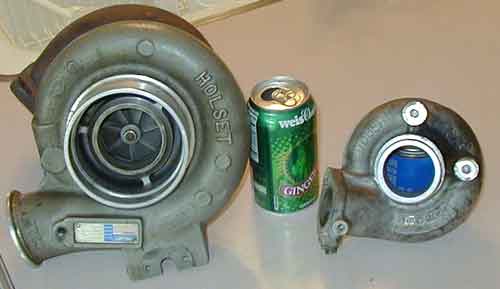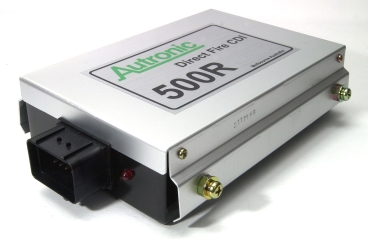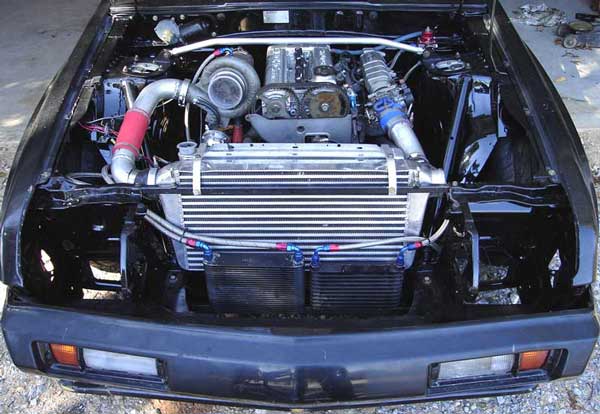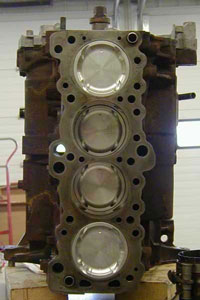The Drift Car's Engine
I was astounded by the interchangeability that I found when researching the 4G63 engine during the first swap. There were so many great combinations of engine components that DSM people were putting together. I also had learned valuble lessons about transmission options during the first swap. Coming into this I had 3 requirements:
- 4G6X Sirius Family motor - Facilitated MPI and DOHC
- Wideblock - For use with stronger RWD transmission options
- Larger Displacement - For faster spooling, more torque
Use the '+' and '-' buttons to the left to expand or hide details about each section.
Bottom End
- Block: 4G64 6 bolt Wideblock
- Crank: OEM Forged 100mm Stroke
- Rods: Scat 150mm Length
- Pistons: Wiseco .020 Over (Summit Racing P/N: WIS-K564M87)
- Bearings: Clevite 77
- Main Studs: ARP
- Rod Bolts: ARP
- Head Studs: ARP
- Balance Shafts: Eliminated
Because I used the 6 bolt bottom end, many parts were available for the bottom end.
The balance shafts were eliminated without a kit. I cut the oil pump shaft and had it welded. I also pressed out the other shaft's bearings and pressed them in to block off the oil holes. The timing cover was blocked off by JB welding in a freeze plug and using a crush washer on a bolt for the balance shaft pulley mounting hole. One day I plan on replacing the balance shaft gear on the crank with an OEM spacer.
I used a 1990 oil filter housing for my engine as well. This allowed me to use an external heat exchanger. I used 16mm x 1.5 to -8AN adapter fittings so that I could run -8 lines to my cooler. With drifting you can be at high boost, full throttle, high revs for such a long time that oil cooling becomes critical.
Timing
- DOHC 6 bolt 4G6x DOHC brackets and gears
- DOHC 6 bolt 4G6x DOHC front cover / oil pump
- Re marked 2.0L Cam Gears to match 1994 Galant GS Gears (MD300439 & MD189399)
- New OEM Tensioner (MD308587)
- New OEM Pulleys (MD156604 & MD129355)
- New OEM 4G64 Timing Belt (MD182292)
I actually got most of my timing parts off of a Hyundai 1.8L motor. The timing parts are basically the same as any other 6 bolt DOHC 4G6x motor. All used parts were disassembled, cleaned and inspected. I used a 6 bolt timing cover on my engine. I could not use a 2.4L SOHC lower timing cover or a 7 bolt Galant GS Timing cover either. Therefore the top 3 bolts of the timing cover do not line up by 6mm. I used small zipties for 2 of these and that works fine. You can get more info on the timing changes associated with the SOHC -> DOHC swap here.
Top End
- Head: 1G 4G63 DOHC "Big Port"
- Valves: Stock
- Springs: Brian Crower
- Rockers: Stock
- Lifters: Stock
- Retainers: Titanium (Brian Crower)
- Cams: Force Performance 3
I am currently using 1G 4G63 DOHC head. This head is using the stock porting and stock valves. I am using Force Performance 3 cam shafts. These cams were developed and optimized for the 100mm stroke of the 2.4L crank. Aspects of the cams have been optimized due to the lower revs of the stroked motors, faster piston speeds and longer dwell times. These cams use high ramp rates and therefore require the use of upgraded valves springs and lighter retainers. I chose Brian Crower springs and retainers.
Turbo

- Turbo: Holset HX35
- Turbine Housing: 9cm^2 from Bullseye
- Oil feed: Restricted -6AN line
For the turbo, I wanted to go BIG. I knew alot of people using GT35R turbos. Great turbos, but at $1300 they were too much for my STRICT budget. I had been reading up on Holset turbos and they really intriuged me. The, first, are HUGE by most people standards (visually bigger than a GT35R). I also had access to an efficiency map which put my power needs and boost levels right in the sweet spot. Here are some quick facts about the Holset HX35 turbo:
- Available on Dodge Cummins Diesel trucks with a variety of options.
- A VERY modern design, decades newer than a comparable 60-1
- Standard 360 degree thrust bearings (Garrett calls them "race bearings")
- Some models feature a Map Width Enhancement Groove which helps to prevent surging (and it looks BAD ASS).
- Available with 12cm (0.89 A/R) (Divided T4), 16cm and 18cm housings. You can also purchase a 9cm (0.65 A/R) from Bullseye with either a T3 or Mitsubishi flange. ( To add some perspective the stock DSM housing is 6cm2 but the 4G63 has used up to 10.5cm2 from the factory ( Evo 6.5 )
- Available used for much less than a GT series turbo.
The turbo manifold is at this point a working prototype. We flipped an SS Autochrome manifold over by cutting off the flange and rewelding it. The turbo is braced so hopefully this will lengthen its life. This will be used until I can build a stronger manifold.
Fuel
- Autronic SMC v1.92
- 950cc fuel injectors
- Dual 255lph Walbro GSL392 (External) Fuel Pumps
- Aeromotive AEI-13109 fuel pressure regulator
- Lots of -AN lines and fittings.
Originally I was going to use a stock ECU with some sort of piggy back. I quickly would have outgrown the SAFC so I was looking at the DSMlink. I then started adding up the component prices of each option:
- 1G EPROM ECU - $200+ (and over 10 years old)
- 1G DSM Link - $595 + shipping (includes socketing service)
- 2G MAS - Too Restrictive
- 3" GM MAF - $40
- MAF Translator - $200
- Total: $1035
- Second hand full standalone computer - $600-1000
- Total: $600-1000
or
It was an easy decision. I started shopping. I was looking for a used Electromotive TEC2 which you can find for around $500-800, or really any number of used ECUs. I was also considering used AEM units. On a whim I started looking for ECU's made by a company called Autronic. These ECU's were always at the high end of the market (the company used to make Motec). I found that the basic Autronic SMC model was available for around $1600 new and $1200-1400 used. I called Mack at Fast Track Performance about a $1200 used ECU he were selling. Sadly, he had sold out of those, but he did have one with a bad MAP sensor. He said he'd have it fixed up and warranteed as new for only $500. SWEET! After a few weeks of waiting the ECU arrived. It came with a basic engine harness and he even threw in some nice easy to disconnect fuel injector plugs. Guess it pays to look around even if you dont think you'll be able to afford it.
I decided to use dual 255lph pumps due to cost, but also for redundancy. I plan on making around 600hp, maybe not all the time, but if I do, I want to be ready. I believe a 255lph pump will support around 500hp, so I knew I would need more. I was going to get an Aeromotive A1000, but upon reading the technical details, decided it was not for me. I then asked the guru's at Special Stage what I should do. Many of them recommended dual of even tripple 255lph fuel pumps all on seperate circuits. If an A1000 went out at the track you'd be down for a week, if one of the Walbro's die I just need to turn the boost down to 25psi and replace it when I get home. I also found a seller on ebay selling the External GSL392 pumps for $100 shipped. $200 sure beat the $300+ for the A1000. These are fed by separate -8 feeds from a sumped 20 Gallon Aluminum fuel cell. From there they are fed via -6 lines to a T fittings and up to the front via a single -6 braided line. Once in the engine bay I feed fuel into the front of the rail by 4x 950cc FIC injectors and then back into -6 lines to an Aeromotive fuel pressure regulator mounted on the firewall. The fuel return is handled by a single -6 line.
Spark

- Ignition: Autronic Direct Fire CDI
- Coils: Denso from a Suzuki GSXR (Coil On Plug)
- Plug wires: None
- Spark Plugs: NGK BP7ES
- Tach Adapter: Autronic
After some initial troubles with two different used MSD DIS-4s, I ordered an Autronic Direct Fire CDI through Kevin Black, a dealer and tuner in PA. He had this shipped from Australia and it was in my hands only 3 days after it was ordered. Amazing! The R500 is a 4 channel ignition system as well. It has been used on other engines up to 2000hp. It has multispark like the MSD and is FAR more reliable. It is also lighter and more compact. It is very basic and has no troublesome dip switches or dials. On a 4 cylinder engine it has the ability to trigger each spark plug independent of the others. Also, since it is a CDI, I do not need to worry about coil dwell times associated with inductive systems.
I could have used other coil options but I wanted something else. Coil On Plug has been used in OEM applications for several years now. This, like it states, places the coil ON the plug. I may appear at first to be an expensive, negligably stronger, novalty, but in reality, it comes down to price:
- GM coils - $40
- Quality Plug Wires - $60+
- GSXR CoP - $40
or
Transmission
Mazda RX7 Turbo II Series 5
While I could have used the stock Starion transmission, I decided to go with this transmission. I have heard many good things about its strength and have seen some very high power RX7s before. This did cost a little more to implement, but hopefully it will avoid the annoying, costly and time consuming transmission replacements (I was going through Mitsubishi Transmissions every 6 months with the last swap). More info on this transmission setup can be found on the transmission section of Project Zero G.
© 2012 Cybernetics


